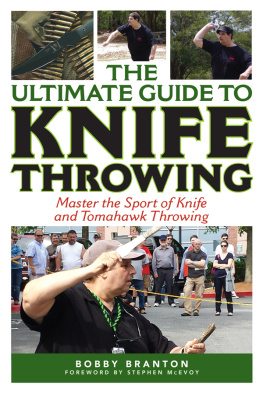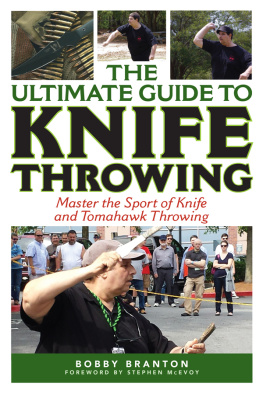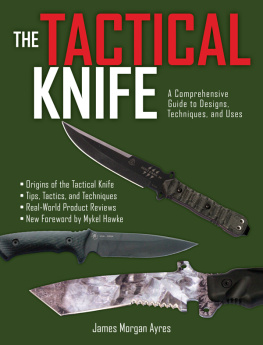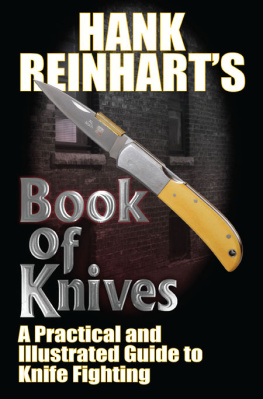TABLE OF CONTENTS
Guide

Having spent his formative years on the banks of the Hatchie River in the small town of Mercer, Tennessee, Mike Yarbrough yearns for the hardihood and old-school wisdom so common in generations past. He is the founder of Wolf & Iron (wolfandiron.com) and has a passion for helping men heed the high call of manful living. He now resides in Charlotte, North Carolina, with his lovely wife and two handsome sons.
A knifeless man is a lifeless man.
NORDIC PROVERB
As we peer through the ages of manly history and literature, we see the pocket knife taking a backseat to its august brothers, the sword and the dagger. We know the tales of Excalibur and Carnwennan, King Aurthurs sword and dagger, as well as Tolkiens Andril and Sting, and Jim Bowies mighty blade that bears his name. Missing are the tales of the humble pocket knife. The reason for this is not that the pocket knife is a new invention, but that it is and has always been common. It is the grunt, not the general; a squire not yet knighted. And while it may be through the sword we know many grand tales, it is through the pocket knife that we know the man. The small knives found by archaeologists over the years, just as those passed down in recent generations, are markers of lives lived and work done. In them is a touch of the everyday and a deeper connection to the past than we can experience in their magnanimous counterparts.
Some of the earliest evidence of a foldable knife appeared in Austria and dates back to 600500 BC, a time when Romans occupied the territory. It seems our ancestors were also not keen on stabbing themselves in the crotch, and thus mother necessity once again gave birth.
I can see it now: Manulus and his Roman compadres are huddled around a fire, shooting the breeze and talking about things such as virtues and Romulus and Remus and how fortunate they were that Romulus was the brother that lived, else they would be called Remans, which just sounds weird. As the throng of men are nodding in agreement that the aqueduct was the swellest thing ever invented and how nothing would ever top it, Manulus, nonchalantly, pulls out his pocket knife, flips it open, and proceeds to cut into a pear. Though hes pretending to look off into the distance, out of the corner of his eye he can see his pals taking notice, and hears a quell in the spirited conversation. One man says what the others are thinking: Say, Manulus, whats that you have there? to which Manulus responds, playing dumb, Its a pear. Youve all seen pears, right? Want a slice?
No, man, that knife thing you have. Where did you get that?
Got it? Oh, no, I made this. Just a little something I worked up this weekend, replies Manulus, to which could be heard the guttural sounds of approval from his eager audience.
As this new folding knife makes its rounds through the host of men, one remarks, Well, I bet he couldnt make one with a stag horn handle, to which Manulus responds, By Zeus whiskers, I bet I can. Ill even polish the steel.
And so the challenge was taken up, and this new version, which was created with an eye toward form as well as function, was received more heartily than the first. At this point, some of Manulus friends began to feel quite asinine for their previous esteem and admiration of the aqueduct, which seemed to them, now, to be an artless turd river compared to this fine new implement, and they all began placing orders for Manulus new invention, which he dubbed the Sans Stabby.
While this may not be a truly historical account of how it went down, what we do know is that in the centuries to come, the folding knife is seen everywhere, from the arsenals of Vikings to the pockets of field hands. The style of knives ranged from fancy to formidable, but the basic operation remained true to the original. It isnt until the 1600s, however, that we begin to see a stable design pattern that appealed to the mass of the common man. Enter the peasant knife.

There are a number of things for which we owe the humble peasant a firm handshake and pat on the shoulder. Of course, it would be prudent to immediately shower afterwards, but he has his thanks coming just the same. Without the ages of the struggling lower class, we wouldnt have things such as these:
BaconOnce thought of as a cheap cut of meat, now considered food royalty.
A hearty immune systemThanks to the Black Plague and generations stewing in their own filth, our bodies have adapted to the otherwise deadly world in which we live.
Pitch forks and torchesHow else is one supposed to run monsters out of the village?
BaconSo good, its worth a second mention!
And, of course, the peasant knife, an affordable friction folder produced in Sheffield, England. It should come as no surprise that it was this unassuming design that became the stolid workmate of many a farmer. Friction folders are a simple design still employed to this day. The snug fit of the blade in the handle is what holds the blade in position. The straightforward design of the knife allowed it to be mass-produced and sold to the common man for a mere English copper, by which the knife got the nickname penny knife, and the rough use of the knife on the farm and in the fields earned it another name, sod buster.
Perhaps the greatest testament to the peasant knife is that it is still a stable sidekick. The French company Opinel has been making a fine version of the peasant knife since 1890. Its a fantastic folder to keep in the glove box and tool box, plus it still has a classic look that pairs perfectly with camping trips. I suppose other people feel the same, for as of the writing of this book, Opinel sells around 15 million of their knives a year. Peasants everywhere, unite!
The success of the peasant knife and the burgeoning of the Industrial Revolution spawned an advance in knife technology that has scarcely slowed since the mid-1600s. As the Industrial Revolution paved the way for a middle class and afforded them a higher standard of living, the marketplace opened in a way never before seen. In the 1700s, competition amongst inventors of all kinds became fierce as the patent system began in earnest, and knife makers were keen to create and patent new designs for a tool which had been around for a millennium.
Not long after the peasant knife appeared on the scene, a truly revolutionary knife design was born: the slip joint. Every man knows this one well, as it is the basis for the familiar style of knives which have dominated the market for several generations. The slip joint is so called because it does not have a true joint, such as a ball and socket, but slides steel on steel. The bottom of the blade, called a tang, rotates against a piece of flexible steel, called a backspring. Rather than having an actual coil spring mechanism, which would weaken over time, the backspring creates pressure. That pressure, along with the shape of the tang, is what causes a traditional pocket knife to set in both the half-open and open positions.
As the slip joint came into its own, variations in designs began to spring up. Some came about in response to the need for different blades to accommodate different types of work, but others were made solely for looks. What was once thought to be merely a tool started to become a statement. Just as a man may have an eye toward the aesthetic in his work, he could now afford the same luxury in his everyday tools. The following knives include the most notable designs to come about in the 1900s.
Next page











